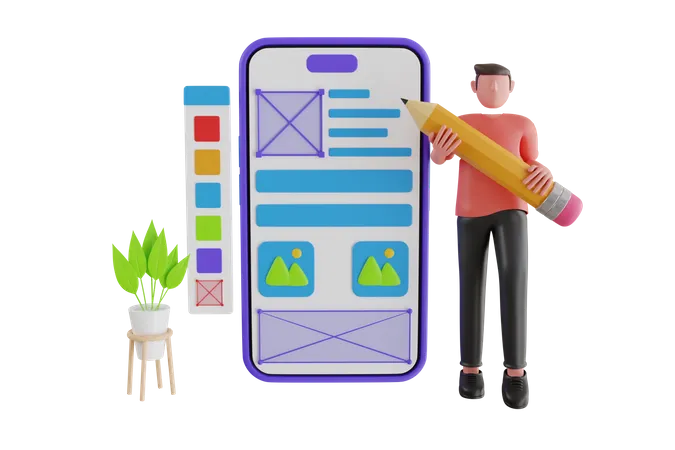- October 1, 2024
- by Christopher
- UI/UX Design, Web Design, Web Development
User Experience (UX) design is often viewed as an optional investment, but in reality, UX design is a critical driver of business success. A well-designed user experience can significantly boost customer satisfaction, retention, and ultimately, revenue. In this post, we’ll dive deep into the ROI of UX and how better designs can directly and indirectly increase your bottom line.
What is UX Design, and Why Does it Matter?
UX design focuses on optimizing the user journey by creating intuitive, accessible, and engaging interfaces. It considers everything from how quickly users can navigate your site, how easy it is to complete tasks, and how well the design aligns with user needs. The goal is to remove friction and make the user experience as seamless as possible.
A Forrester Research study revealed that a well-designed user interface could raise a website’s conversion rate by up to 200%, while better UX design could yield conversion rates up to 400%. This shows that UX is not just an aesthetic choice—it’s a business decision that can lead to significant financial returns.
How UX Design Impacts Revenue
1. Increased Conversion Rates
One of the most direct ways UX design contributes to revenue is through improved conversion rates. Whether it’s optimizing an e-commerce checkout process or simplifying lead capture forms, a better UX can remove barriers that prevent users from converting.
- Example: If a website’s checkout process is complex or unintuitive, users are likely to abandon their carts. By simplifying the design, removing unnecessary steps, and ensuring a smooth experience, businesses can see immediate improvements in completed purchases.
- Impact: Studies show that businesses see an average 83% lift in conversion rates after improving their UX.
2. Reduced Customer Acquisition Costs (CAC)
Attracting new customers can be expensive. However, a well-designed website or app with a seamless user experience can reduce the friction in the customer acquisition funnel, making it easier and cheaper to bring in new customers.
- Example: A website with poor navigation and unclear messaging will require higher marketing and sales efforts to acquire the same number of customers as one with streamlined UX and content. By making it easier for users to understand your value proposition and navigate through your site, you reduce the need for as much paid marketing or long-term nurturing.
- Impact: By lowering bounce rates and improving lead flow, better UX can reduce CAC by up to 50%.
3. Enhanced Customer Retention
It’s well-known that retaining a customer is much more cost-effective than acquiring a new one. Great UX encourages users to return by providing a positive, consistent experience across interactions.
- Example: A mobile app with an intuitive, well-organized interface will keep users engaged, while a confusing app will cause churn. A clear user journey combined with value-added features keeps users coming back.
- Impact: Companies that prioritize UX see a reduction in customer churn, sometimes by as much as 15-20%.
4. Higher Customer Lifetime Value (CLTV)
Better designs don’t just bring in more customers; they increase the amount each customer spends. Happy users tend to become loyal, repeat customers who are also more likely to explore other products or services you offer.
- Example: A subscription service that focuses on delivering a frictionless onboarding experience and continually optimizes the user’s interaction with its platform will see customers stay longer and spend more on upsells and cross-sells.
- Impact: Increasing CLTV by even 5% can lead to an overall revenue increase of up to 25-95%, according to studies from Bain & Company.
5. Reduced Support Costs
A poorly designed product or website can result in confused users, which translates into higher customer support costs. Intuitive UX can drastically reduce the number of help tickets or support calls.
- Example: An e-commerce site where users have a hard time tracking their orders will lead to increased inquiries about order statuses. Simplifying the user dashboard or offering more self-service options through UX design can reduce this burden.
- Impact: By improving UX, companies have been able to reduce customer service costs by up to 30%.
The Cost of Bad UX
A study by IBM found that teams that emphasize good UX reduce the time spent on addressing usability issues by 50%, allowing them to focus more on innovation and customer growth. Just as good UX can boost revenue, bad UX can destroy it. A few key ways bad design negatively impacts revenue include:
- High Bounce Rates: Users leave a site quickly if they don’t find what they need, or if the site is slow, cluttered, or difficult to navigate.
- Abandoned Carts: A complicated checkout process can lead to cart abandonment, directly impacting sales.
- Negative Reviews and Poor Word-of-Mouth: Bad experiences are more likely to be shared. Users who experience frustration with your product or service will discourage others from engaging with your brand.
- Loss of Competitive Edge: A poorly designed product may lose to a competitor that offers a more polished, intuitive experience.
Measuring the ROI of UX Design
While some UX benefits, like improved brand perception, are harder to quantify, others offer clear metrics. To calculate the ROI of UX, businesses can look at key indicators before and after design improvements, such as:
- Conversion Rate (CR): Measure the percentage of users who complete the desired action (e.g., making a purchase, signing up).
- Customer Acquisition Costs (CAC): Track how much it costs to bring in a new customer.
- Customer Lifetime Value (CLTV): Measure the total revenue a business can expect from a single customer over their relationship with the brand.
- Task Success Rate: Measure how often users are able to complete a task successfully, which reflects the usability of a product or system.
- Customer Satisfaction (CSAT): Monitor feedback to see how happy users are with the experience.
For example, if a business spends $100,000 on UX design improvements but sees a 10% increase in conversion rates and a 15% reduction in customer support costs, the return on that investment is likely to far exceed the initial cost.
The Bottom Line
Investing in UX design is not just about creating aesthetically pleasing products; it’s about delivering real business value. A well-thought-out UX strategy can improve conversion rates, reduce customer churn, and drive higher revenues. It also helps businesses save on support costs and attract more customers with less marketing effort.
Ultimately, good UX design pays for itself—and then some. By improving your users’ experience, you create more satisfied customers, build brand loyalty, and generate more revenue. Therefore, considering the ROI of UX is a smart business decision that can drive sustainable growth.
Conclusion: UX isn’t just a design discipline—it’s a revenue driver. Businesses that focus on improving the user experience see measurable improvements across all aspects of their operation, from customer acquisition to support costs, conversions, and customer loyalty. It’s clear that better design equals better business results. Contact Us today to improve the UX design of your website.


